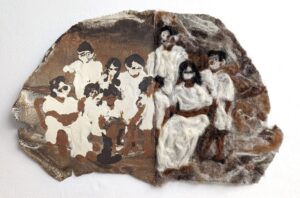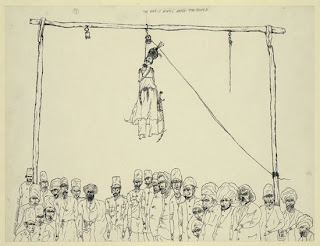
Ardeshir Mohasses The king is always above the people from the series Life in Iran (1978) ink on paper; Library of Congress, Prints and Photographs Division
Ardeshir Mohassess at the Asia Society, New York
Contemporary media and the internet delude us with the fiction that we have access to global knowledge, yet much of the world escapes our sight. I’m grateful to the Asia Society for time and again expanding my view, as it does with it’s current exhibition devoted to extraordinary drawings by the Iranian satirist, Ardeshir Mohassess (through August 3). As repressive as the Bush administration has been, ours is still a society where one can criticize the regime with impunity. As such it continues to be a refuge for those whose own rulers are less secure in their power. Mohassess came to the U.S. during the Shah’s rule and his visit turned into extended exile after the post-revolutionary theocracy came to power, for it would be equally intolerant of his criticism.
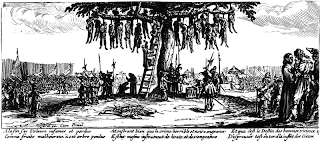
Jacques Callot Hanged men ( Les pendus) from the series The miseries of war (Les misères de la guerre) (1633), etching. Callot’s series was a precedent for Goya’s Disasters of War.
Mohassess’ piercing vision is drawn with a pen dipped in bitter truths. An artist who chooses the brutalities of war and abuses of power has subjects that are both universal and timeless; a body hanging from a noose looks much the same in Qajar Iran (1833-1925, where Mohassess sets his images although they clearly concern the present), in Callot’s 17th century Lorraine or in 20th century American lynching photographs. And the supercilious faces of the attendants, standing calmly as the king himself executes the condemned man, are all too familiar.
Mohassess’ early drawings of the 1960s have something of the character of Edward Lear’s illustrations for children’s books, but for their subjects. In one a man is held on a table as a top-hatted figure cuts off one leg; another exits right with a severed arm and others wait, knives in hand, to take their turn at dismemberment. Sometimes Mohassess ads irony to his images by giving them titles straight out of government propaganda: The king stops in front of the representatives of political convicts and had a little chat with them shows the regent, in splendidly-decorated uniform, addressing 5 blindfolded men who are tied to stakes and obviously await execution.
Some of the drawings combine fatalism with their anger; Today’s martyrs demonstrate in honor of tomorrow’s martyrs implies an endless oppression. Yet while Mohassess depicts a people who are used to the worst of societies, both they and the artist continue to agitate for something better.
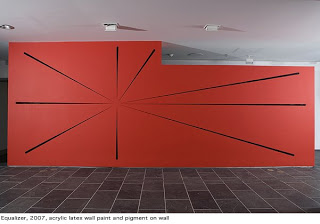
Odita at the Studio Museum
Odili Donald Odita, has been a professor at Tyler for several years and his work has been seen internationally, including at last summer’s Venice Biennale and at DAK’ART 2004, the Dakar Biennial , yet as far as I know the only time it’s been seen in Philadelphia was when the PMA hung one canvas in a ground floor gallery earlier this year. He’s the first artist chosen by the Studio Museum of Harlem for a new program whereby artists are asked to create a work for a space of their choosing. Odita selected four walls of a room in the basement which is part of a recent expansion of the Studio Museum’s exhibition space. (it will be on view through June 29).
He’s covered them with abstract painting with a program. Odili states that Equalizer represents the displacement of Africans to the United States and their life as African-Americans. The first wall one sees on descending is an intense, fire-y red with black lines radiating from a central void which seems to glow; whether that’s a product of the lighting or an after-effect of vision I couldn’t tell. Turning clockwise are three walls more characteristic of Odita’s other work: uninflected geometric forms of many colors.
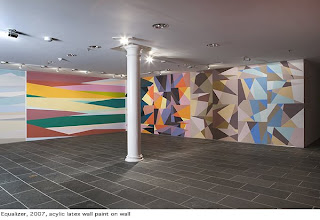
Odili Doanld Odita Equalizer (detail) 2007 acrylic latex wall paint and pigment on wall at the Studio Museum
Odita ‘s desire for an abstract art that will carry a message to a broad audience recalls Malevich and his fellow Russians of the revolutionary period. While I can’t say I was able to discern Odita’s stated subject, he’s created a stunning set of paintings.
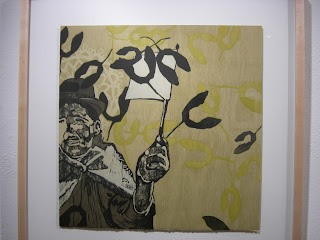
Katie Baldwin Parade I (2008) woodblock
Katie Baldwin’s non-linear narratives at the University City Arts League, Philadelphia
Katie Baldwin is a master printmaker who has absorbed the graphic traditions (particularly of woodcuts) from various cultures. She’s spent time in Mexico, Cuba and Japan, and her work combines some of the best of Western political posters and broadsheets with a Japanese sensitivity to the grain of the wood.
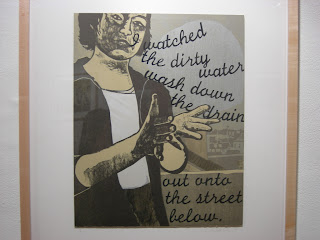
Katie Baldwin Good Kid/Bad Kid II from The Rooftop Series (2008) woodblock and screenprint
She says her prints complete each other in a non-linear narrative, and indeed they often contain words or have titles of a deadpan incompleteness that reminds me of Dottie Attie’s similarly abbreviated storytelling. Baldwin speaks of the point where politics and power meet the everyday, her own version of the early feminist statement that the personal is the political. These serial prints are something between a primer and a journal. The exhibition is on view at the University City Arts League through June 7.


